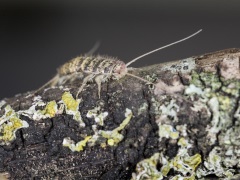Features
A family affair
Date: 2018-02-27 10:11:42.0
Author: Jon Evans

Firebrats (Thermobia domestica) can feed on
the cellulose in wood.
Photo: The University of York.
Lytic polysaccharide monooxygenases (LPMOs) are a recently-discovered class of biomass-degrading, copper-based enzymes. Unlike cellulases and other conventional biomass-degrading enzymes, LPMOs don’t cleave the bonds in long sugar molecules such as cellulose and hemicellulose by hydrolyzing them, but rather by oxidizing them (see Out with the old). Because of this different mode of action, LPMOs are beginning to be incorporated in the enzyme cocktails used to convert cellulose and hemicellulose into fermentable sugars for the industrial production of cellulosic biofuels.
Now, though, two overlapping teams of British and French scientists have discovered two new families of LPMOs, which could help to make these enzyme cocktails even more efficient. Each new family is unusual in its own way: one is able to break down hemicellulose, which none of the previously discovered LPMOs has been able to do; the other was found in the gut of an insect, where no LPMOs have been discovered before.
“Back in 2010 we made the key discovery that a group of enzymes found in fungi contain copper – these enzymes are now known to be an important component in the decomposition of biomass by biology,” said Paul Walton, a chemist at the University of York who is a member of both teams. Since then, Walton and other scientists have discovered that LPMOs can also be produced by bacteria and viruses, and grouped them into four families, based predominantly on whether they prefer to break down cellulose, chitin or starch.
With these two recent studies, Wilson and his colleagues have now increased the number of known LPMO families by 50%. As reported in a paper in Nature Chemical Biology, they discovered one of the new families in white-rot and brown-rot fungi, which play a major role in the natural decay of wood. This is the first LPMO family known to be able to break down xylan, the main hemicellulose in wood. Interestingly, the LPMOs couldn’t break down xylan in solution, but only when it was attached to cellulose microfibrils, indicating that the specific conformation xylan adopts when bound to cellulose is an important factor.
The fact that xylan binds to cellulose microfibrils is one of the reasons why deriving fermentable sugars from wood is so difficult, because the xylan protects the cellulose from attack by cellulases. This is why wood needs to be broken down by strong chemicals in a pre-treatment step before the cellulases can reach the cellulose. Adding these xylan-degrading LPMOs to enzyme cocktails may remove the need for this expensive pre-treatment step, as the LPMOs will remove the protective xylan from the cellulose, exposing it to the cellulases.
As reported in a paper in Nature Communications, Wilson and his colleagues found their second novel LPMO family in an insect called a firebrat (Thermobia domestica), which is known to feed on plant biomass. The firebrat is closely related to the silverfish and a member of one of the oldest groups of insects. By analyzing the proteins in the gut of firebrats fed on cellulose, the scientists identified 21 LPMOs able to cleave cellulose into glucose molecules.
Then, by searching public proteomic databases, they found proteins with similar amino acid sequences in a range of other invertebrates, including crustaceans, molluscs, millipedes, spiders and various insects. This indicates that this new family of LPMOs are both widespread among invertebrates and, when combined with the fact that firebrats belong to a group of insects that have been around for over 400 million years, quite ancient.
Seeing as LPMOs are known to be able to break down chitin, Wilson and his colleagues propose this family originally evolved to remold the insect exoskeleton, which is primarily made of chitin, during development. “We found that these ancestral genes [for LPMOs] are essential for metamorphosis and that interfering with their function is lethal to insects,” said Simon McQueen-Mason, a biologist at the University of York. Subsequently, the firebrat seems to have co-opted these LPMOs for breaking down cellulose.
Now, developers of enzyme cocktails can hopefully co-opt them for more efficient production of cellulosic biofuels.
The views represented here are solely those of the author and do not necessarily represent those of John Wiley and Sons, Ltd. or of the SCI.
Displaying 3 keywords used to tag this article:
- Copy Watches Rolex New Watch Automa
- Nib Authentic Roger Vivier Flats Ro
- Лучшие Реплика Longine
